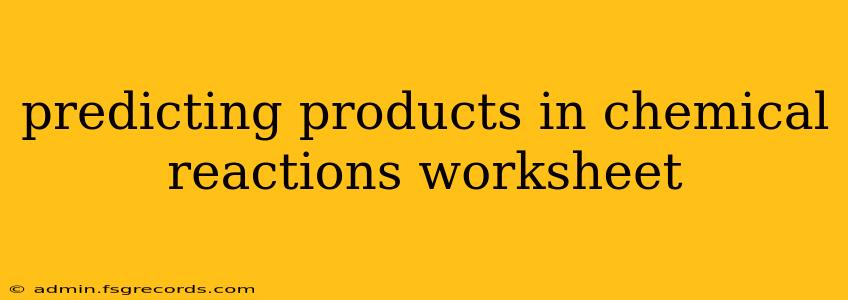Predicting the products of chemical reactions is a fundamental skill in chemistry. This worksheet guide will walk you through various reaction types, providing strategies and examples to help you master this crucial concept. Whether you're a high school student tackling your chemistry homework or a college student preparing for exams, this guide offers a structured approach to predicting reaction outcomes.
Understanding Different Reaction Types
Before diving into predictions, it's essential to familiarize yourself with common reaction types. Recognizing the type of reaction is the first step towards accurately predicting its products.
1. Synthesis (Combination) Reactions:
These reactions involve two or more reactants combining to form a single product. The general form is: A + B → AB
Example: 2Na(s) + Cl₂(g) → 2NaCl(s) (Sodium and chlorine combine to form sodium chloride)
Prediction Strategy: Identify the reactants and determine if they can combine to form a stable compound. Consider oxidation states and the resulting compound's properties.
2. Decomposition Reactions:
These reactions involve a single reactant breaking down into two or more simpler products. The general form is: AB → A + B
Example: 2H₂O(l) → 2H₂(g) + O₂(g) (Water decomposes into hydrogen and oxygen)
Prediction Strategy: Consider the stability of the reactant. Heating or applying electricity often drives decomposition reactions. Look for patterns in the breakdown of common compounds.
3. Single Displacement (Substitution) Reactions:
In these reactions, a more reactive element replaces a less reactive element in a compound. The general form is: A + BC → AC + B
Example: Zn(s) + CuSO₄(aq) → ZnSO₄(aq) + Cu(s) (Zinc replaces copper in copper sulfate)
Prediction Strategy: Use an activity series (reactivity series) of metals or nonmetals to determine which element is more reactive and will undergo displacement.
4. Double Displacement (Metathesis) Reactions:
These reactions involve the exchange of ions between two compounds, often resulting in the formation of a precipitate, a gas, or water. The general form is: AB + CD → AD + CB
Example: AgNO₃(aq) + NaCl(aq) → AgCl(s) + NaNO₃(aq) (Silver nitrate and sodium chloride react to form silver chloride precipitate and sodium nitrate)
Prediction Strategy: Consider the solubility rules to predict the formation of precipitates. Look for the formation of weak acids, weak bases, or gases.
5. Combustion Reactions:
These reactions involve the rapid reaction of a substance with oxygen, often producing heat and light. The reactants are usually a hydrocarbon and oxygen, and the products are carbon dioxide and water.
Example: CH₄(g) + 2O₂(g) → CO₂(g) + 2H₂O(g) (Methane combusts in oxygen to form carbon dioxide and water)
Prediction Strategy: For hydrocarbons, predict CO₂ and H₂O as products. For other substances, consider the oxidation products in the presence of oxygen.
Practice Problems and Solutions (Worksheet Section)
(This section would contain a series of practice problems, each categorized by reaction type. Solutions would be provided at the end of the worksheet.)
Example Problem 1 (Synthesis): Predict the product of the reaction between magnesium (Mg) and oxygen (O₂).
Example Problem 2 (Decomposition): Predict the products of the decomposition of calcium carbonate (CaCO₃) upon heating.
Example Problem 3 (Single Displacement): Will iron (Fe) displace copper (Cu) from copper(II) sulfate (CuSO₄)? Explain your answer.
Example Problem 4 (Double Displacement): Predict the products of the reaction between lead(II) nitrate (Pb(NO₃)₂) and potassium iodide (KI). Indicate the precipitate.
Example Problem 5 (Combustion): Predict the products of the combustion of propane (C₃H₈).
(Solutions to the above problems would follow here, with explanations for each prediction.)
Advanced Concepts
For more advanced learners, consider exploring these topics:
- Redox Reactions: Understanding oxidation states and electron transfer.
- Acid-Base Reactions: Neutralization reactions and pH changes.
- Organic Chemistry Reactions: Predicting products in organic reactions involving functional groups.
This comprehensive worksheet guide provides a framework for predicting products in chemical reactions. Consistent practice and a solid understanding of reaction types are key to mastering this important skill. Remember to consult your textbook and other resources for additional practice problems and explanations.

